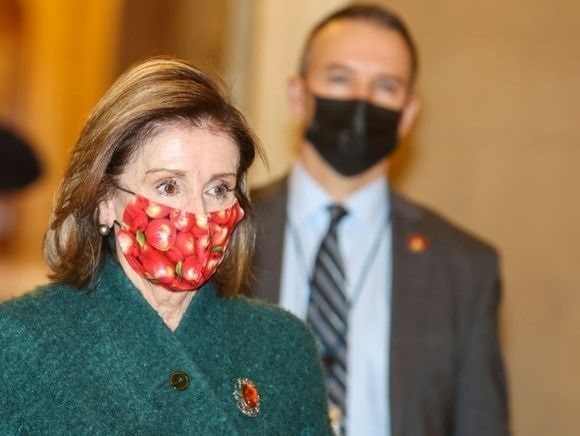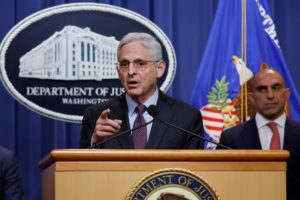
Nancy Pelosi (Photo by Tasos Katopodis/Getty Images)
The $2.2 trillion CARES Act, the $1.9 trillion American Rescue Plan (ARP), and the billions in additional federal, state, and local stimulus and relief spending were promoted as essential expenditures to cushion the blows from the coronavirus pandemic. Be it the paycheck protection program (PPP) or the sweetened unemployment benefits, it turns out that there was plenty of fraud and waste in all three levels of government, in addition to the inflation that this astronomical fiscal expansion triggered. In the end, how much did US households really receive in pandemic benefits, and how much was abused?
The Brass Tacks
 Following the passage of President Joe Biden’s signature ARP, more than $6 trillion in deficit-financed spending was handed out to millions of Americans throughout the once-in-a-century public health crisis, including stimulus checks, child tax credits (CTC), and unemployment insurance, according to a March 2021 study by the Tax Foundation. The report noted that the typical family of four whose breadwinner lost his or her job received more than $50,000 in benefits, including Lost Wages Assistance, CARES Act, December 2020 relief package, unemployment insurance benefits, and ARP.
Following the passage of President Joe Biden’s signature ARP, more than $6 trillion in deficit-financed spending was handed out to millions of Americans throughout the once-in-a-century public health crisis, including stimulus checks, child tax credits (CTC), and unemployment insurance, according to a March 2021 study by the Tax Foundation. The report noted that the typical family of four whose breadwinner lost his or her job received more than $50,000 in benefits, including Lost Wages Assistance, CARES Act, December 2020 relief package, unemployment insurance benefits, and ARP.
But while this is a massive figure, new reports are spotlighting how much fraudulent activity took place as these funds were being allocated to the public, whether large corporations or average households.
Luxury Vehicles, Courtesy of Taxpayers
Over the last 18 months, there have been many reports, estimates, and dollar figures thrown around about how much had been wrongfully taken from the US government. Experts concede that it will be challenging to come up with an exact total, but the broad array of probes and analyses suggest that odious people took advantage of the crisis to enrich themselves and their families. With the latest string of announcements, the American people can approximate how much had been fleeced from taxpayers.
In March, IRS investigators announced that they had uncovered more than $1.8 billion in fraudulent behavior pertaining to the federal coronavirus stimulus funds. The tax agency revealed that it had investigated and closed 660 criminal cases related to multiple stimulus efforts, most of which consisted of wire fraud involving culprits who submitted false claims about their financial situations to qualify for taxpayer funds.
“These cases included a broad range of criminal activity, including fraudulently obtained loans, credits and payments meant for American workers, families, and small businesses,” the IRS Criminal Investigation Division said in a statement.

(Photo by Spencer Platt/Getty Images)
Just before Christmas, the US Secret Service announced that close to $100 billion had been stolen from COVID-19 relief programs that were established in support of businesses and out-of-work individuals. This estimated figure was created using data from the Secret Service, the Small Business Administration, and the Department of Labor. Although it represented only about 3%, the report noted that criminals were attracted to the enormous size of the pot with little chance of oversight.
The Department of Labor inspector general projected that $87 billion of the $872 billion in COVID jobless payments were paid improperly, mainly due to fraud. Moreover, NBC News reported in March that many individuals participated in the theft of about 10% of the $800 billion PPP, resulting in the thieves buying luxury vehicles, acquiring mansions, taking opulent vacations, and hiring private jets. The SBA inspector general pinpointed more than $78 billion in possibly bogus Economic Injury Disaster Loans, although the Secret Service says this figure is closer to $100 billion. The Government Accountability Office (GAO) claimed that Washington sent more than one million economic impact payments from the CARES Act to dead people. Even people living abroad had been sent $1,200 stimulus checks, from Austria to Sweden, according to a separate IRS study.
In the annual Festivus Report 2021, Senator Rand Paul (R-KY) highlighted examples of waste of COVID funds. For example, a Baltimore, MD, school received $1.27 million in relief money for students who were not enrolled in the institution. Or, in another instance, former New York City Mayor Bill de Blasio (D) spent $25 million of federally funded coronavirus aid to establish the City Arts Corps, paying 3,000 artists to display their art as part of broader efforts to “resurge the cultural scene.”
But what happened? How did it get so bad? It had to do with the sheer size of these packages and how fast the money was distributed, says Glenn Fine, a non-resident fellow at the Brookings Institution.
“The oversight of COVID expenditures has been difficult, in light of the vast amount of spending, the speed by which it was distributed, and the lack of adequate existing safeguards or internal controls over the spending,” he wrote in a report.

Merrick Garland (Photo by Chip Somodevilla/Getty Images)
Last year, Attorney General Merrick Garland established a task force to target pandemic-related fraud, and in March the White House noted that the task force would include agents and prosecutors. The Justice Department recently confirmed that its fraud section prosecuted more than 150 defendants in nearly 100 criminal cases and seized $75 million in funds from the PPP.
Never Again?
Eminent economist Milton Friedman famously identified how government spending works: using your own money for yourself, using your own money for someone else, using someone else’s money for yourself, and using someone else’s money for someone else. The first two would require due diligence and concern for the cost, while the other two would not spawn much consternation or care for the price. This principle, conservative and libertarian economists would purport, is emphasized in annual budgetary outlays and emergency spending. This is why politicians and bureaucrats are routinely adamant about spending money to solve problems and spur economic growth, despite decades of wasting and abusing precious taxpayer dollars. To quote Friedman’s Chicago colleague, Thomas Sowell, “The first lesson of economics is scarcity: there is never enough of anything to fully satisfy all those who want it. The first lesson of politics is to disregard the first lesson of economics.”
Remember to check out the web’s best conservative news aggregator
Whatfinger.com — the #1 Alternative to the Drudge

